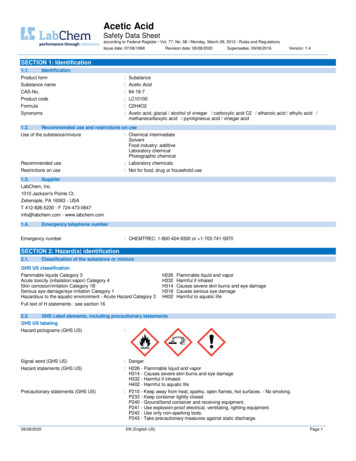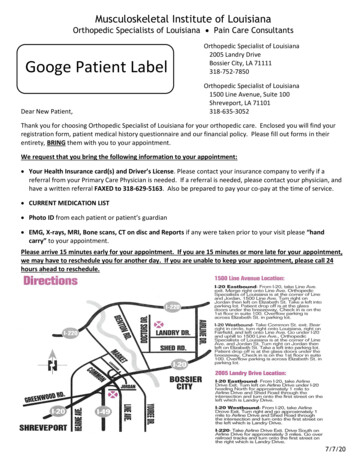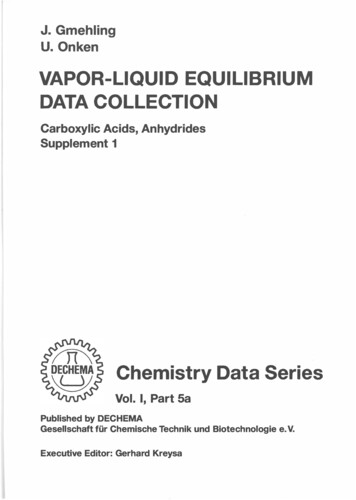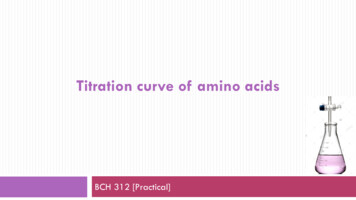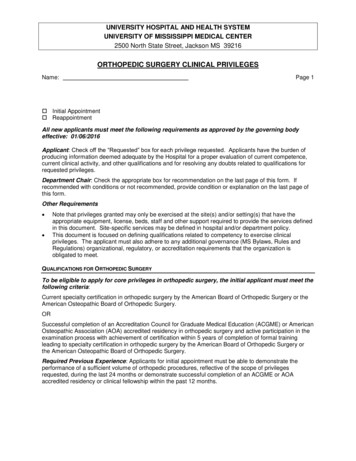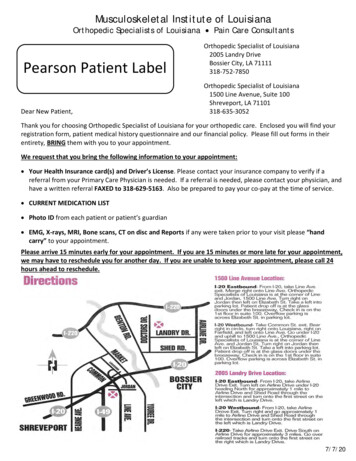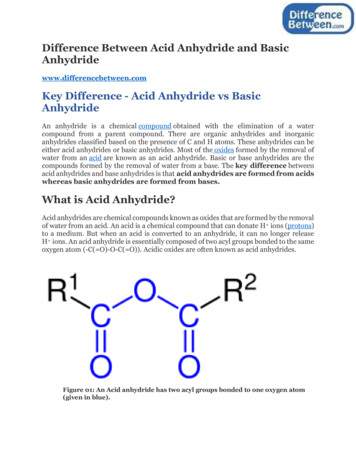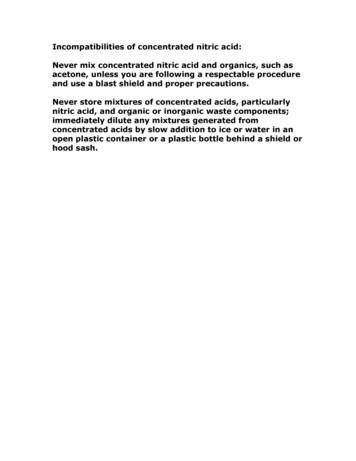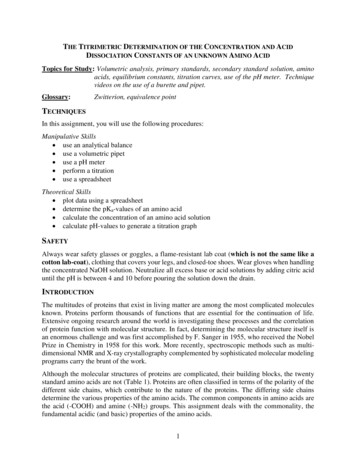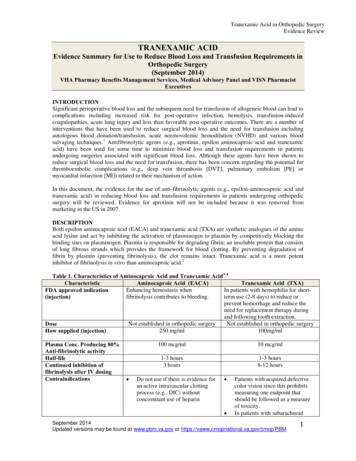
Transcription
Tranexamic Acid in Orthopedic SurgeryEvidence ReviewTRANEXAMIC ACIDEvidence Summary for Use to Reduce Blood Loss and Transfusion Requirements inOrthopedic Surgery(September 2014)VHA Pharmacy Benefits Management Services, Medical Advisory Panel and VISN PharmacistExecutivesINTRODUCTIONSignificant perioperative blood loss and the subsequent need for transfusion of allogeneic blood can lead tocomplications including increased risk for post-operative infection, hemolysis, transfusion-inducedcoagulopathies, acute lung injury and less than favorable post-operative outcomes. There are a number ofinterventions that have been used to reduce surgical blood loss and the need for transfusion includingautologous blood donation/transfusion, acute normovolemic hemodilution (NVHD) and various bloodsalvaging techniques.1 Antifibrinolytic agents (e.g., aprotinin, epsilon aminocaproic acid and tranexamicacid) have been used for some time to minimize blood loss and transfusion requirements in patientsundergoing surgeries associated with significant blood loss. Although these agents have been shown toreduce surgical blood loss and the need for transfusion, there has been concern regarding the potential forthromboembolic complications (e.g., deep vein thrombosis [DVT], pulmonary embolism [PE] ormyocardial infarction [MI]) related to their mechanism of action.In this document, the evidence for the use of anti-fibrinolytic agents (e.g., epsilon-aminocaproic acid andtranexamic acid) in reducing blood loss and transfusion requirements in patients undergoing orthopedicsurgery will be reviewed. Evidence for aprotinin will not be included because it was removed frommarketing in the US in 2007.DESCRIPTIONBoth epsilon aminocaproic acid (EACA) and tranexamic acid (TXA) are synthetic analogues of the aminoacid lysine and act by inhibiting the activation of plasminogen to plasmin by competitively blocking thebinding sites on plasminogen. Plasmin is responsible for degrading fibrin; an insoluble protein that consistsof long fibrous strands which provides the framework for blood clotting. By preventing degradation offibrin by plasmin (preventing fibrinolysis), the clot remains intact. Tranexamic acid is a more potentinhibitor of fibrinolysis in vitro than aminocaproic acid.2Table 1. Characteristics of Aminocaproic Acid and Tranexamic Acid3-4CharacteristicAminocaproic Acid (EACA)Tranexamic Acid (TXA)Enhancing hemostasis whenIn patients with hemophilia for shortFDA approved indicationfibrinolysis contributes to bleeding.term use (2-8 days) to reduce or(injection)prevent hemorrhage and reduce theneed for replacement therapy duringand following tooth extraction.Not established in orthopedic surgeryNot established in orthopedic surgeryDose250 mg/ml100mg/mlHow supplied (injection)Plasma Conc. Producing 80%Anti-fibrinolytic activityHalf-lifeContinued inhibition offibrinolysis after IV dosingContraindications 100 mcg/ml10 mcg/ml1-3 hours3 hours1-3 hours8-12 hoursDo not use if there is evidence foran active intravascular clottingprocess (e.g., DIC) withoutconcomitant use of heparin Patients with acquired defectivecolor vision since this prohibitsmeasuring one endpoint thatshould be followed as a measureof toxicity.In patients with subarachnoidSeptember 2014Updated versions may be found at www.pbm.va.gov or https://vaww.cmopnational.va.gov/cmop/PBM1
Tranexamic Acid in Orthopedic SurgeryEvidence Reviewhemorrhage. Anecdotal experienceindicates that cerebral edema andcerebral infarction may be causedby TXA in some patients. In patients with activeintravascular clotting. In patients with hypersensitivity toTXA or its ingredients.Warnings/precautions EACA should not be administered Convulsions have been reported in(selected)without a definite diagnosis and/orassociation with TXA particularlylab finding indicative ofwith higher doses and during CVhyperfibrinolysis.surgery and in patientsaccidentally given TXA into the Rapid IV injection should beneuraxial system.avoided since this may inducehypotension, bradycardia and/or Dose should be reduced in patientsarrhythmia.with renal insufficiency Inhibition of fibrinolysis by Patients with history ofEACA may theoretically result inthromboembolic disease may be atclotting or thrombosis.increased risk for venous orarterial thrombosis. Should not be administered withFactor IX complex conc. Or Anti- Should not be administered withinhibitor Coagulant conc. sinceFactor IX complex conc. Or Antithe risk for thrombosis increases.inhibitor Coagulant conc. since therisk for thrombosis increases.CV cardiovascular, DIC disseminated intravascular coagulation, EACA epsilon aminocaproic acid, IVintravenous, TXA tranexamic acidSUMMARY OF THE EVIDENCE (Refer to Appendix 1 for detailed results)There have been a number of published systematic reviews and meta-analyses of anti-fibrinolytics inminimizing blood loss and transfusion requirements in patients undergoing orthopedic surgery. Since someof them are as recent as 2014, only those analyses published after 2010 have been included.5-14Additionally, no individual clinical trials, examining tranexamic acid or aminocaproic acid, were detailedin the evidence tables since many are included in the meta-analyses and most are limited by small samplesize and are inadequately powered to determine the efficacy and safety of these agents with morewidespread use. Most of the studies included in the meta-analyses excluded high risk patients includingthose patients undergoing joint revision procedures, patients with bleeding diatheses or receivinganticoagulation, history of thromboembolic events, cardiovascular disease or renal failure. Therefore, theefficacy and safety of antifibrinolytics in these subgroups of patients is unknown.Most of the available evidence for use of antifibrinolytics in orthopedic surgery exists for tranexamic acidand only a few studies with epsilon aminocaproic acid. However, there is one study conducted in patientsundergoing total knee replacement surgery in which patients were randomized to antifibrinolytics (TXA orEACA) or placebo. Total blood loss and the proportion of patients receiving transfusion with allogeneicblood were significantly less in the antifibrinolytic-combined group vs. placebo. The authors noted thatthere were no significant differences in outcomes between TXA and EACA but the numbers were small(n 35 TXA vs. n 33 EACA) and therefore, the study may have been underpowered to identify differencesbetween the treatment groups. There is one meta-analysis published in 2006 that identified only four trialsusing EACA in orthopedic surgery, two in total hip arthroplasty (THA), one in spine surgery and one incancer patients having orthopedic surgery. The authors of this meta-analysis did not report a benefit ofEACA from these studies.16 Another meta-analysis of antifibrinolytics that included studies involvingaprotinin, EACA and/or TXA pooled the findings and reported an overall benefit of antifibrinolytics forreducing total blood loss and transfusion requirements with no resultant increase in the risk forthromboembolic events. However, because of the heterogeneity of the pooled estimates, small sample sizeof the included studies and the use of varied dosing regimens, the authors recommended a large,prospective, randomized clinical trial be conducted.September 2014Updated versions may be found at www.pbm.va.gov or https://vaww.cmopnational.va.gov/cmop/PBM2
Tranexamic Acid in Orthopedic SurgeryEvidence ReviewEvidence from the meta-analyses, detailed in Appendix 1, does consistently show a benefit of TXA versuscontrol in reducing total blood loss by an average of approximately 500 ml in TKA and 300-400 ml in THAand reducing requirement for transfusion by 45% in TKA and 20-30% in THA. In total knee arthroplasty,the tourniquet used during surgery is believed to increase fibrinolysis after deflation with an increased riskof bleeding. In terms of an increased risk for thromboembolic events with the use of antifibrinolytic agentsin orthopedic surgery, the available evidence does not support a higher risk (DVT or PE or MI) vs. control.However, most of the authors of the meta-analyses cited small trial size as an obvious limitation toconcluding safety with routine use of these agents in orthopedic surgery and recommend larger,prospective, randomized trials be conducted to address the question of thromboembolic risk andmortality.18-19 Evidence is insufficient to determine the safety and efficacy of EACA in orthopedic surgeryor in comparison to TXA.DOSE/DOSE FREQUENCY OR TIMING/ROUTE OF ADMINISTRATIONEvidence exists for the use of intravenous (IV), intra-articular (IA) or topical irrigation of joint with TXAfor reducing total blood loss and transfusion requirements in orthopedic surgery. Most of the trials usedintravenous bolus dosing (single or repeated) or continuous infusion of TXA as opposed to intra-articular ortopical use. Topical irrigation doses of TXA range from 500 mg-3 grams in 50-100 ml saline. Intraarticular doses range from 250 mg-2 grams in 20-50 ml saline.20 Evidence is insufficient to identify theoptimal dose, route of administration and proper timing of dose. In several of the meta-analyses, a trendtowards greater benefit was noted with higher doses of TXA. However, very high doses of TXA haverarely been associated with seizures.4There are three trials comparing various routes of administration of TXA in orthopedic surgery. In the firsttrial, four different IV dosing regimens (all doses were 10 mg/kg 1) intraoperative dose given beforetourniquet deflation, 2) preoperative and intraoperative dose, 3) intraoperative and postoperative dose, 4)preoperative, intraoperative and postoperative dose) and one local application were compared to placebo,with forty patients undergoing TKA in each group. The single intraoperative dose was not effective; thetwo-dose regimen (preoperative and intraoperative dose) was effective vs. control in reducing drain bloodand total blood loss with TKA; but the intraoperative and postoperative dose was not. The preoperative,intraoperative and postoperative dosing regimen was most effective. 21 Intra-articular and IV dosing werecompared to placebo in 150 patients having TKA. The timing of the intervention was during closure of theoperative wound. Tranexamic acid 1.5 gm was mixed with 100 ml saline and given IV or IA. Total bloodloss was 528 ml in the IV group, 426 ml in the IA group and 833 ml in the placebo group. Transfusion wasrequired in 44% IV, 20% IA and 94% placebo. Transfusion amounts were 273 ml IV, 129 ml IA and 921ml placebo.22 In another trial, patients having THA were randomized to receive TXA (varied timing) orplacebo. Groups included: 1) placebo, 2) 1 gm TXA 10 min before skin closure, 3) 1 gm TXA 10 minbefore closure and again 6 hr. later, 4) 1 gm TXA 10 min prior to surgery, and 5) 1 gm TXA 10 min priorto surgery and 6 hr. later. The authors reported that dosing 10 minutes prior to surgery and again 6 hr. laterwas the most effective regimen.23Because most trials were small, used various doses of TXA, routes of administration and timing of dosingin various orthopedic surgery types, the optimal dosing regimen for TXA for reducing total blood loss andtransfusion requirements in TKA or THA is unknown.CONCLUSIONSThere is increasing interest in using antifibrinolytic agents for minimizing blood loss and transfusionrequirements in patients undergoing orthopedic surgery, namely joint replacement surgery. There havebeen a number of mostly small trials, which have consistently shown at least a trend towards benefit ofTXA in both TKA and THA without an increased risk for thromboembolic complications. Evidence islimited for using EACA in orthopedic surgery. Findings are consistent from a number of meta-analyseswhich have demonstrated reduced total blood loss by a mean of 500 ml in TKA and 300-400 ml in THAand a reduced need for transfusion of allogeneic blood by about 45% in TKA and nearly 30% in THA withTXA versus control. A majority of the authors of the meta-analyses have cited limitations includingheterogeneity of study findings, small trial sample size, varied doses, timing and routes of administration ofTXA, thereby precluding them from drawing conclusions regarding safety with more widespread use andfrom identifying the optimal dosing regimen. In addition, since many high-risk groups of patients (e.g.,September 2014Updated versions may be found at www.pbm.va.gov or https://vaww.cmopnational.va.gov/cmop/PBM3
Tranexamic Acid in Orthopedic SurgeryEvidence Reviewjoint revision surgery, history of thromboembolic events, cardiovascular disease, bleeding diatheses orreceiving anticoagulation, renal failure, etc.) were excluded from clinical trials, the safety and efficacy oftranexamic acid in these patients is unknown.REFERENCES1. Tse EYW, Cheung WY, Ng KFJ, et al. Reducing Perioperative Blood Loss and Allogeneic BloodTransfusion in Patients Undergoing Major Spine Surgery. J Bone Joint Surg Am 2011;93:12681277.2. Eubanks JD. Antifibrinolytics in Major Orthopedic Surgery. J Am Acad Orthop Surg2010;18:132-138.3. http://www.accessdata.fda.gov/drugsatfda icar lbl.pdf Epsilon Aminocaproic Acid4. http://www.accessdata.fda.gov/drugsatfda docs/label/2013/019281s031lbl.pdf Tranexamic Acid5. Alshryda S, Sarda P, Sukeik M, et al. Tranexamic Acid in Total Knee Replacement. A SystematicReview and Meta-Analysis. J Bone and Joint Surg BR 2011;93B;1577-1585.6. Yang ZG, Chen WP, Wu LD. Effectiveness and Safety of Tranexamic Acid in Reducing BloodLoss in Total Knee Arthroplasty: A Meta-Analysis. J Bone Joint Surg Am 2012;94:1153-1159.7. Tan J, Chen H, Liu Q, et al. A Meta-Analysis of the Effectiveness and Safety of UsingTranexamic Acid in Primary Unilateral Total Knee Arthroplasty. J Surg Res 2013;184:880-887.8. Pantelli M, Papakostidis C, Dahabreh Z, Giannoudis PV. Topical Tranexamic Acid in Total KneeReplacement: A Systematic Review and Meta-Analysis. The Knee 2013;20:300-309.9. Sukeik M, Alshryda S, Haddad FS, Mason JM. Systematic Review and Meta-Analysis of the Useof Tranexamic Acid in Total Hip Replacement. J Bone Joint Surg Br 2011;93-B:39-46.10. Zhou XD, Tao LJ, Li J, Wu LD. Do We Really Need Tranexamic Acid in Total Hip Arthroplasty?A Meta-Analysis of Nineteen Randomized Controlled Trials. Arch Orthop Trauma Surg2013;133:1017-1027.11. Gandhi R, Evans HMK, Mahomed SR, Mahomed NN. Tranexamic Acid and the Reduction ofBlood Loss in Total Knee and Hip Arthroplasty: A Meta-Analysis. BMC Research Notes2013;6:184-197.12. Poeran J, Rasul R, Suzuki S, et al. Tranexamic Acid Use and Post-Operative Outcome in PatientsUndergoing Total hip or Knee arthroplasty in the United States: Retrospective Analysis ofEffectiveness and Safety. BMJ 2014;349:g4829 doi: 10.1136/bmj.g482913. Yang B, LiH, Wang D, He X, et al. Systematic Review and Meta-Analysis of PerioperativeIntravenous Tranexamic Acid Use in Spinal Surgery. PLOS-ONE 2013;8;e55436:1-9.14. Huang F, Wu D, Ma G, et al. The Use of Tranexamic Acid to Reduce Blood Loss and Transfusionin Major Orthopedic Surgery: A Meta-Analysis. J Surg Res 2014;318-327.15. Camarasa MA, Olle G, Serra-Prat M, et al. Efficacy of Aminocaproic, Tranexamic Acids in theControl of Bleeding During Total Knee Replacement: A Randomized Clinical Trial. Br J Anaesth2006;96:576-582.16. Zufferey P, Merquiol F, Laporte S, et al. Do Antifibrinolytics Reduce Allogeneic BloodTransfusion in Orthopedic Surgery? Anesthesiology 2006;105:1034-1046.17. Kagoma YK, Crowther MA, Douketis J, et al. Use of Antifibrinolytic Therapy to ReduceTransfusion in Patients Undergoing Orthopedic Surgery: A Systematic Review of RandomizedTrials. Thrombosis Research 2009;123:687-696.18. Henry DA, Carless PA, Moxey AJ, et al. Anti-Fibrinolytic Use for Minimizing PerioperativeAllogeneic Blood Transfusion. Cochrane Database of Systematic Reviews 2011,Issue 3. Art. . Ker K, Edwards P, Perel P, et al. Effect of Tranexamic Acid on Surgical Bleeding: SystematicReview and Cumulative Meta-Analysis. BMJ 2012;344:e3054 doi: 10.1136/bmj.e305420. Ipema HJ, Tanzi MG. Use of Topical Tranexamic Acid or Aminocaproic Acid to Prevent BleedingAfter Major Surgical Procedures. Ann Pharmacother 2012;46:97-107.21. Maniar RN, Kumar G, Nayak RM. Most Effective Regimen of Tranexamic Acid in KneeArthroplasty. A Prospective Randomized Controlled Study in 240 Patients. Clin Orthop Relat Res2012;470:2605-2612.September 2014Updated versions may be found at www.pbm.va.gov or https://vaww.cmopnational.va.gov/cmop/PBM4
Tranexamic Acid in Orthopedic SurgeryEvidence Review22. Seo JG, Moon YW, Park SH, et al. The Comparative Efficacies of Inra-Articular and IVTranexamic Acid for Reducing Blood Loss During Total Knee Arthroplasty. Knee Surg SportsTraumatol Arthrosc 2013;21:1869-1874.23. Imai N, Dohmae Y, Suda K, et al. Tranexamic Acid for Reduction of Blood Loss During TotalHip Arthroplasty. J Arthroplasty 2012;27:1838-1843.September 2014Updated versions may be found at www.pbm.va.gov or https://vaww.cmopnational.va.gov/cmop/PBM5
Tranexamic Acid in Orthopedic SurgeryEvidence ReviewAPPENDIX 1Table 2: Systematic Reviews/Meta-Analyses of Anti-Fibrinolytic Agents in Orthopedic SurgeryCitation (# of includedPopulation/OutcomesConclusionsstudies, N, other details)InterventionResultsAlshryda 20115(19 trials, n 1277)Trials were small, rangingfrom 24-136 participants.Different doses andmethods of delivery wereused.All but two studies usedLMWH for DVTprevention.Yang 20126(15 trials, n 837)Trials were small, rangingfrom 20-102 participantsOnly trials rated as highquality were included(Jadad 3).TOTAL KNEE ARTHROPLASTYTKA, TXA doseranged from 700 mg to10,500 mg.TXA vs. placebo or nocontrolIV, oral or topical usewas acceptable: 18 studies used IV 1 study also usedoral in addition toIV 1 study usedtopicalComparators: 18 usedplacebo and 1 usedNVHDTKA, 14 studies usedlow dose TXA 1050mg/kg and 1 highdose, 150 mg/kg.Route of administration(IV or topical) notprovided.Comparators: placeboand both group usedpneumatic tourniquetsProportion of patients transfused:14 trials (n 824)TXA led to reduction in proportion of ptsrequiring transfusion (RR 2.56, 95% CI2.10-3.11, p 0.001). Trials did showconsistent benefit but significantheterogeneity between study findings(I2 75% suggesting high heterogeneity orhigh inconsistency)Number of units transfused:13 trials (n 769)Crude pooled data show a four-foldincrease in the number of units transfusedin the group not receiving TXATotal blood loss:9 trials (n not stated)Mean difference of 591 ml between TXAand control (95% CI 536-647 ml,p 0.001). Significant heterogeneity wasfound I2 78%)Length of hospital stay:2 trials (n 60)NSComplications (death, non-fatal MI,stroke, DVT or PE or any thrombosis,renal failure and re-operation due tobleeding:DVT: 13 trials (n 801), p 0.98, I2 0%heterogeneityPE: 19 trials (n 971). 5 reported PE, 1 inTXA and 4 controls. P 0.5Death: 1 in each group p 0.98Total blood loss:14 studies (n 817), Mean difference of504.90 ml less in the TXA vs. placebogroup (95% CI 620.89-388.92,p 0.00001).Number of units transfused:6 trials (n 348). Number of transfusionsin the TXA group was significantly lessvs. control WMD: -1.43 units (95% CI 1.69 to -1.17, p 0.00001)Odds Ratio for transfusion:14 trials (n 735) OR 0.16, 95% CI 0.100.25, p 0.00001Odds Ratio for developing DVT:14 trials (n 722) 10 DVT TXA vs. 13placebo. (OR 0.75, 95% CI 0.34-1.67,p 0.48)Odds Ratio for developing PE:Heterogeneity in findings wasnoted in 1) proportion ofpatients transfused and in 2)total blood loss. Subgroupanalysis identified that a morehomogenous treatment effect ofTXA was noted with higherdoses ( 4000 mg) and asmaller, heterogeneous effectwas noted for lower doses.Explanations for variabilitybetween studies are numerousincluding surgical technique,when the tourniquet wasreleased, dose, timing andmode of administrationdiffered, etc. Authors didacknowledge some evidence ofpublication bias where smallertrials with neutral findingscould be missing.Limitations include the inabilityto analyze functional outcomesor quality of life due to the lackof that data being reported andstudies were underpowered toassess the safety of TXA inTKA. Pooled safety data do notsupport an increased harm inthese patients.Methods for determiningquantity of blood lost differed.PT, APTT did not changeduring TXA treatmentTXA reduced total blood loss,need for transfusion and thenumber of units transfusedwithout an increase in ADEs.September 2014Updated versions may be found at www.pbm.va.gov or https://vaww.cmopnational.va.gov/cmop/PBM6
Tranexamic Acid in Orthopedic SurgeryEvidence ReviewTan 20137(19 trials, n 1114)Trials were small, rangingfrom 20-102 participantsExclusion criteria in trialsincluded prior cerebralapoplexy,thromboembolic diease,severe liver or kidneyimpairment andcongenital or acquiredcoagulopathiesTKA, 19 trials, nosummary of TXA dosesused were listed.Timing of TXAadministration varied asfollows: 1)intraoperative IVadmin TXA prior totourniquet deflation 2)pre-op and post-op IVadmin TXA beforetourniquet inflation andat 3 hrs after 1st dose,and 3) intraoperativeand post-op IV admin.Prior to tourniquetdeflation and 3 hrslater.6 trials (n 349) 2 PE TXA, 4 placebo(OR 0.65, 95% CI 0.18-2.33, p 0.5)Total blood loss:5 trials (n 374). Reduced blood loss by amean of 570 ml (95% CI -663 to -478,p 0.00001). Significant heterogeneitywas noted (I2 77%)Rate Ratio for transfusion:17 trials (n 1047) Transfusion rate wassignificantly lower in TXA vs. placebo(RR 0.39, 95% CI 0.25-0.61, p 0.00001)Units of blood transfused per patient:15 trials (n 860). Number of unitstransfused per patient was lower withTXA vs. placebo (mean difference: -0.96units, 95% CI -1.32 to -0.59, p 0.00001)Safety:18 trials (n 1094). 12 of 534 pts TXA vs.13 560 pts placebo. (RR 0.89, 95% CI0.43-1.85, p 0.76)Comparators: placeboand groups usedpneumatic tourniquetsPanelli 20138(7 trials, n 517)Trials were small.Trials included excludedthe following pts: use ofanticoagulants andpresence of bleedingdisordersTKA, 7 trials alllimited to topicalapplication of TXA vs.placebo.Low dose was definedas 2 grams or less, highdose was 2 grams ofTXA.Comparators: placeboSukeik 20119(11 trials, n 505)Trials were small, rangingfrom 36-100 participants.Total blood loss:4 trials (n 257). Topical TXA reducedtotal blood loss vs. controls (meandifference: -268.36 ml, 95% CI -491.55ml to -45.18 ml, p 0.02)Transfusion requirements:6 trials (n 512). Lower risk of transfusionin TXA vs. placebo (RR 0.47, 95% CI0.26-0.84, p 0.01. No heterogeneitynoted I2 0%Thromboembolic complications:6 trials (n 477) Five studies, no events.One study, 3 DVTs in 64 TXA, 1 DVT in35 controls (RR 0.55, 95% CI 0.04-8.48,p 0.67)TOTAL HIP ARTHROPLASTYTHA, 11 trials limitedto IV TXA only. Otherroutes were excluded.Doses and modes ofadministration differed:Total blood loss:6 trials (n 310). TXA significantlyreduced total blood loss vs. placebo by289.4 ml (95% CI -440.7 to -138.2 ml,p 0.001). Moderate heterogeneity wasnoted I2 54%Authors noted significantheterogeneity in outcomes.Subgroups were analyzed todetermine cause includingblood transfusion protocols ortriggers, VTE prophylaxis andmode of administration. Theheterogeneity in outcomes wasnot sufficiently explained bythe subgroups. Some variationin the findings may be relatedto timing and frequency ofTXA dosing.Limitations include smallsample size, heterogeneity inmany of the outcomes related toblood loss and transfusionneeds and data are insufficientto analyze functional outcomesor quality of life.Authors call for larger studiesto confirm their findings.Subgroup analysis showedtrend towards greater benefit inreducing transfusionrequirements with higher doseTXA ( 2 grams) butdifferences were notstatistically significant whenstudies were separated andpooled by how and high dose.In terms of included trialquality, only two were rated ashigh quality and three werelower quality.Authors comment thatalthough the differences intransfusion and total bloodloss favored TXA, the clinicalsignificance of the difference(e.g., mean 220 ml less bloodloss) is uncertain.Authors noted that multipledoses and the use of transfusionprotocols produced a greaterrisk reduction in bloodtransfusion (mean 25%) as wellas total blood loss.September 2014Updated versions may be found at www.pbm.va.gov or https://vaww.cmopnational.va.gov/cmop/PBM7
Tranexamic Acid in Orthopedic SurgeryEvidence ReviewMost studies rated asgood qualityAll but three studies usedLMWH for DVTprevention.Most trials excludedpatients with history ofCV disease,thromboembolic events,renal failure, those onwarfarin or a therapeuticdose of LMWH.Zhou 201310(19 trials, n 1030)Trials were small, rangingfrom 39-117 participantsMost trials excludedpatients with history ofCV disease,thromboembolic events,renal failure, those onwarfarin or with bleedingdiathesis or a therapeuticdose of LMWH.11Gandhi(33 Published andunpublished trials 19952012, n 1957)21 trials were of highqualityTXA doses ranged from10-30 mg/kg. In 5studies, a single boluswas given, 3 usedrepeated bolus dosesand 3 used prolongedinfusion.Comparators: placebo(n 9 trials), anotherantifibrinolytic or notreatment (n 2 trials)THA, 19 trials limitedto IV only. Other routes(oral, injection into thearticular cavity or IM)were excluded.Comparators: placeboor nothingBlood transfusion rate:7 trials (n 346). TXA reduced proportionof patients requiring blood transfusion by20% (risk difference -20, 95% CI -0.29 to-0.11, p 0.001). Low heterogeneity wasnoted I2 15%Thromboembolic complications:DVT: 10 trials (n 464). NS (p 0.46)PE: 3 reported PE in 11 trials, 2 in TXAand 1 control group. NS (p 0.76)Total blood loss:7 trials (n 382). TXA reduced total bloodloss be a mean of 305.27 ml (95% CI 397.66 to -212.89 ml, p 0.001)Other studies reported on intraoperativeand post-op blood loss but only totalblood loss is included here.Blood transfusion:18 trials (n ? 1000 ). TXA reducedproportion of patients requiringtransfusion by 28% (95% CI 0.19-0.42,p 0.001)Units of blood transfused per patient:9 trials (n ?). TXA did not reduce theaverage number of transfusions perpatient vs. placebo (WMD: 0.3 units, 95%CI -0.49 to 1.09 units, p 0.45)Thromboembolic complications:19 trials DVT: TXA 15/539 vs. placebo19/535 (OR 0.73, 95% CI 0.36-1.49,p 0.39)3 trials PE: TXA 3/539 vs. 1/535 (OR1.95, 95% CI 0.34-11.06, p 0.45)Two studies included in themeta-analysis did not find abenefit of TXA, one gave TXAat the end of the procedure and3 hours later, the other gave asingle pre-op dose andtransfusion and total blood lossfavored placebo in this study.Because studies excludedhigh-risk patients or thoseundergoing revision surgeriestherefore, conclusionsregarding safety of TXA inthese groups cannot bedrawn. Larger studies arerecommended.Duration of hospitalization wasreported in 2 studies and wasnot different between groups.Dose response trend was notedwith higher doses associatedwith lower total blood loss butnot with intra or post-op bloodloss or transfusion rates.Because studies excluded highrisk patients or thoseundergoing revision surgeriestherefore, conclusionsregarding safety of TXA inthese groups cannot be drawn.Authors note that largerstudies are recommended todefine the optimal TXAregimen and to assess andconfirm the safety and costeffectiveness beforerecommending use in THATOTAL KNEE AND TOTAL HIP ARTHROPLASTYTKA (n 19) and THA(n 14), 33 trials(n 1957). Methods ofadmin: IV in 29 trials,intra-articularly in 3studies, orally in 1study and topical in 1.Comparators: placeboor nothingTotal blood loss:TKA: WMD -1.149 (95% CI -1.209 to -1,p 0.001). Significant heterogeneity wasnoted: I2 85.7THA: WMD -0.504 (95% CI -0.672 to 0.336. Moderate heterogeneity I2 58Blood transfusion:TKA: OR 0.145 (95% CI 0.094-0.223,p 0.001). No heterogeneityTHA: OR 0.327 (95% CI 0.208-0.515,p 0.001) Moderate heterogeneity I2 34Thromboembolic complications:Benefit of TXA found to bemore pronounced in TKA vs.THA.Authors conclude thatincomplete reporting ofcomplications prevented thepooling of safety data andstate that larger trials areneeded to confirm the safetyand efficacy of routine use ofTXA in primary TKA andSeptember 2014Updated versions may be found at www.pbm.va.gov or https://vaww.cmopnational.va.gov/cmop/PBM8
Tranexamic Acid in Orthopedic SurgeryEvidence ReviewPoeran12**Retrospective analysisof 872,416 patientshaving TKA or TKA in510 US hospitals 20062012TKA or THA, IVadministration only.Doses of TXA providedwere grouped asfollows: None, 1000mg, 2000 mg and 3000 mgTKA-DVT: OR 1.030 (95% CI 0.4392.42, p 0.6. No heterogeneityTHA-DVT: 1.070 (95% CI 0.393-2.9,p 0.89. No heterogeneityOverall: TXA 30 DVT, 3 PE, 1 MI vs.control 20 DVT, 4 PE.THA.Of 20,051 patients who received TXA,5486 were matched to patients who didnot receive TXA.Blood transfusion (allogeneic orautologous):OR 0.5, 95% CI 0.45-0.55 favoring TXABlood transfusion (allogeneic)OR 0.47, 95% CI 0.42-0.53 favoringTXAComplications:Thromboembolic: OR 0.86, 95% CI 0.591.25Renal Failure: OR 0.74, 95% CI 0.570.96Combined complications: OR 0.75, 95%CI 0.61-0.92ICU admit: OR 0.85, 95% CI 0.74-0.99Retrospective, propensitymatching showed a 69%reduced need for transfusion.WMD for total blood loss: refers toratio of differences between the mean oftreatment and control divided bystandard deviation. A negative WMDfavors treatment and positive favorscontrol.TXA was not associated withan increased risk forperioperative complicationsinclude renal failure orthromboembolic events.Limitationsretrospective/observational andused administrative resources topull data. Lack of clinical datato determine selective use ofTXA in patients with arterialstents or history of TE disease.Outcomes in certainpopulations of patients areunknown and are ne
Dose Not established in orthopedic surgeryNot established in orthopedic surgery How supplied (injection) 250 mg/ml 100mg/ml Plasma Conc. Producing 80% Anti-fibrinolytic activity 100 mcg/ml 10 mcg/ml Half-life 1-3 hours 1-3 hours Continued inhibition of fibrinolysis after IV dosing 3 hours 8-12 hours

